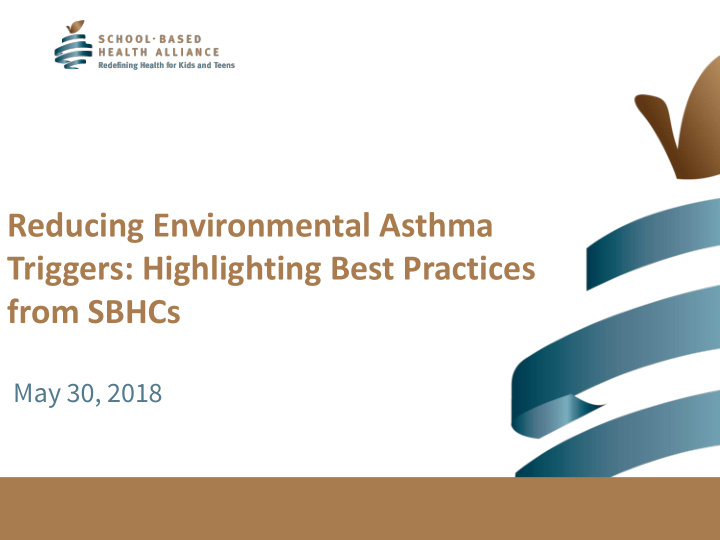



Reducing Environmental Asthma Triggers: Highlighting Best Practices from SBHCs May 30, 2018
Help Us Count! Are you joining as a group? If you are viewing as a group, go to the “Chat” icon and type in the name of the person registered and the total number of additional people in the room. e.g., Tammy Jones +3 This will help us with our final count. Thank you!
Reminders All attendees are in listen-only mode. • We want to hear your questions! To ask a • question during the session, use the “Chat” box that appears on your control panel. Please complete evaluation poll questions at the • end of the presentation.
Webinar Archives Mapping Tool Introduction Confidentiality in School-Based • • Health Care Findings from the 2013-14 Census • Vision Screening 101 • Policy & Advocacy • School-Based Health Alliance Tools • http://www.sbh4all.org/webinars
Today’s Presenters Anne Kelsey Lamb Molly Baldridge Lisa K. Crosby Liz Jacob
Reducing Environmental Asthma Triggers: Highlighting Best Practices from SBHCs and Announcing a New Funding Opportunity
Webinar agenda Overview of the importance of addressing environmental asthma triggers and tools to support SBHCs in doing so Stories from the field : 2 SBHCs share stories about environmental interventions they conducted and the impact they saw Announcement of new funding opportunity Q&A
Asthma in children 7 million children under the age of 18 in the U.S. have asthma Most common cause of disability among children in the U.S. Leading cause of school absences due to chronic disease.
The important role of SBHCs SBHC users are: Less likely to go to the ED or be hospitalized for asthma Less likely to have asthma-related restricted activity days Less likely to miss school as a result of their asthma
Underlying premise of the project: SBHCs provide an ideal setting in which to incorporate environmental components into chronic disease management programs, leveraging their role as a strong link between the student, school, and home.
http://www.rampasthma.org/uploads/asthma_guide_sbhc.pdf
Educating youth to teach their peers about asthma triggers
Linking parents with smoking cessation services
Working with teachers to reduce classroom triggers
Building the capacity of students to conduct home assessments
Educating bus drivers about idling
http://www.rampasthma.org/uploads/casestudies.pdf
Stories from the field Lisa Crosby, South Avondale SBHC Liz Jacobs, West Oakland Middle Schools SBHC
Lessons Learned SBHCs are uniquely positioned to do this work! Passionate, knowledgeable staff. Focus on low-income communities/communities of color. Link between child, school, family, clinical systems. Have more flexibility in working with schools. Adept at doing more with less.
Lessons Learned Start with an environmental assessment. Have one SBHC staff person serve as the lead. Relationship-build. Ask questions to identify perceived barriers. Get buy-in upfront. Identify a champion. Students School staff (principal, teachers)
Lessons Learned, cont. Use existing resources creatively: Buy supplies in bulk, at discounted prices Utilize volunteers/interns Identify partners who can share the work Use existing school communication structures to reach parents and staff Frame policy changes around health impacts
Overview Purpose: Conduct activities to reduce environmental asthma triggers Deadline: August 17 th We strongly encourage you to submit before leaving for break It’s short! You can complete it online at http://www.rampasthma.org/archives/14967 Funding level: $8,000 per site, over two years
Scope of work/expectations Conduct asthma environmental trigger scan Develop a work plan Conduct evaluation activities Participate in peer learning web meetings and individual check-in calls Attend one half-day in-person meeting Contribute stories, photos, lessons learned to the development of a new tool
Application Basic information about: The SBHC The sponsoring agency The project lead
Application Four questions about the work: Why are you interested in participating in this project? Please describe the problem of asthma and/or environmental triggers at your sit e. Please describe initial ideas about the types of interventions and/or types of triggers you would like to address. Please describe any past or current asthma interventions and how participation in this learning collaborative will build upon that.
Questions? Please enter your questions into the “Q&A” inbox of the Zoom control toolbar.
BECOME A MEMBER! BECOME A MEMBER! www.sbh4all.org/membership
National School-Based Health Care Convention JW Marriott Indianapolis 10 S West Street Indianapolis, IN 46204 JOIN US! www.sbh4all.org/convention
Questions? Please enter your questions into the “Q&A” inbox on the Zoom control toolbar.
Thank You! Additional Questions? Contact Anne Kelsey Lamb (anne@rampasthma.org) or Molly Baldridge (mbaldridge@schoolhealthcenters.org)
Recommend
More recommend